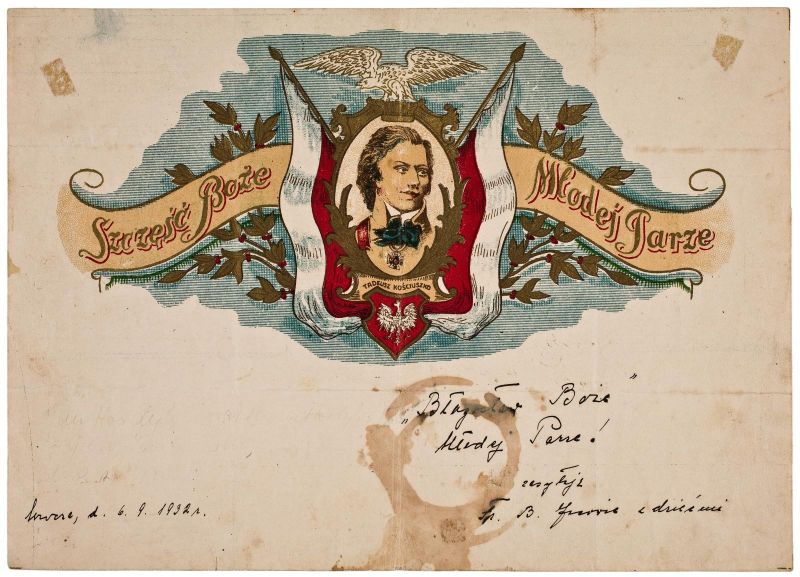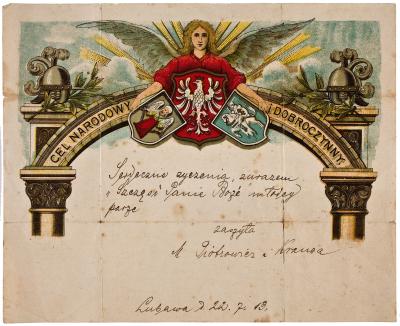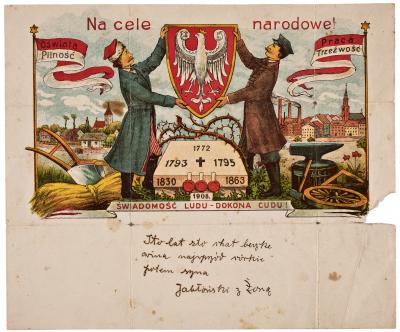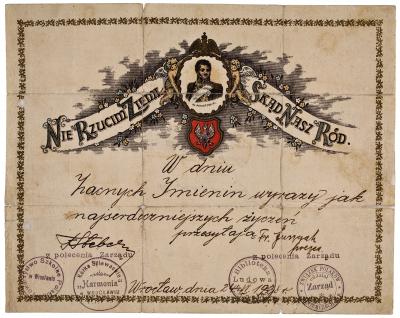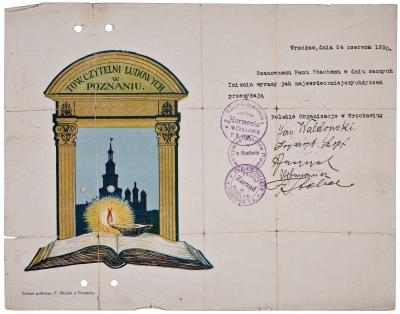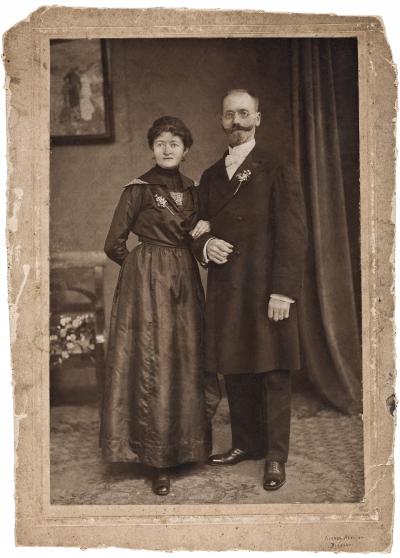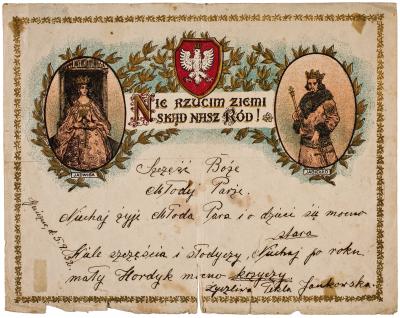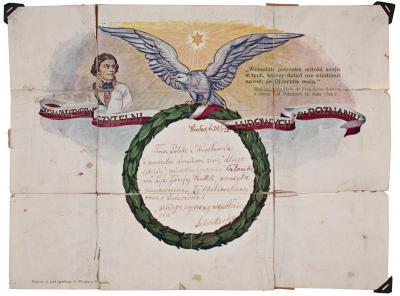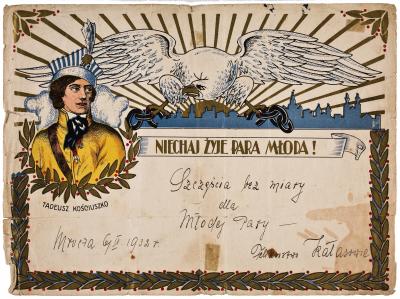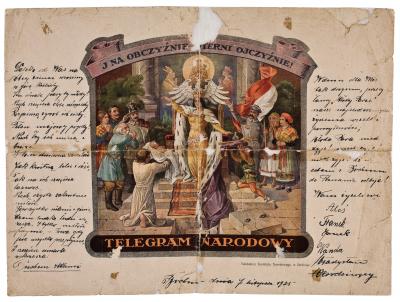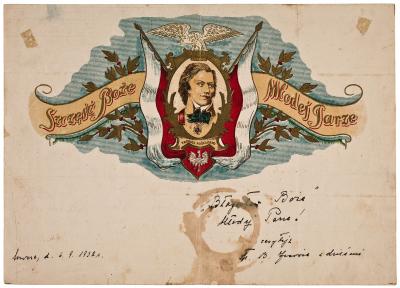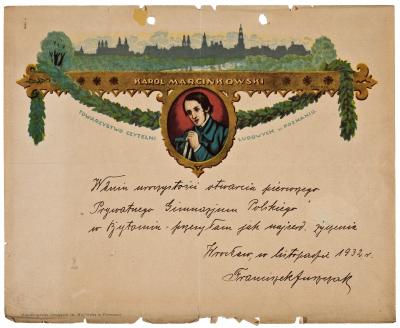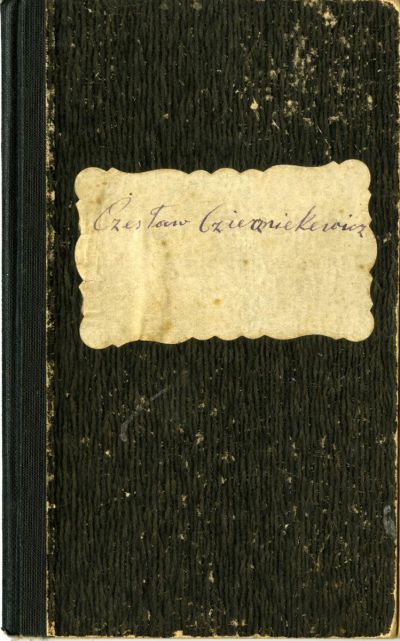“Faithful to the Fatherland, even in foreign lands”. Patriotic telegrams from the Polish diaspora in Wrocław
Mediathek Sorted

The telegram is adorned with a colour lithograph as an allegory to the resurrection of Poland along with the inscription: “I na obczyźnie wierni Ojczyźnie!” (Faithful to the Fatherland, even in foreign lands!)[21] Polonia can be seen at the centre of the composition. She is clad in an ermine coat, is protected by Our Lady of Czestochowa and a white Eagle and receives offerings accompanied by freedom fighters and representatives of the people. The Polish national flag in the top right-hand corner lends the telegram an explicit national character. The pre-printed telegram was issued by the Komitet Narodowy (Polish National Committee) in Berlin. The generous composition distinguishes the telegram as the most impressive work in the entire collection although it is very badly damaged, unfortunately.
The most recent telegram is from 1932 and, like the others, has strong links to the activities of the Polish organisations in Germany. It was sent from Wrocław in November 1932 on the occasion of the opening of the private Polish grammar school in Bytom. This grammar school was the first Polish School to be founded in Germany. It was opened on 8 November 1932.[22] This classic grammar school espoused the teaching of the ancient languages of Latin and Greek. There was an understanding that: “The safeguarding of the national and cultural requirements of such a large number of Poles in Germany is the primary focus of the Polish societies and that the national and civic education and training of the younger generation are extremely important.”[23] Within a very short time, the school was extremely popular with Poles throughout Germany. The Polish community placed great value on this institution. The pupils published their own school newspaper entitled “Idziemy” (Let’s go).[24]
At the time, the sender of the telegram, the tailor Franciszek Juszczak, was the managing director of the Wrocław branch of the Union of Poles in Germany and as such was the leader of the Poles living in Wrocław. “He was a born community worker and a patriot through and through. The Polish issues in Wrocław defined his whole life.”[25] Juszczak was a charismatic man to whom the Polish diaspora in Wrocław owed a debt of gratitude for the fact that they were able to survive He preached tirelessly that “the Fatherland and the Polish people have the highest value and every strength should be invested in serving them. The equity of the Polish issue in Germany should never be called into question”.[26]
The telegram that was sent from Wrocław to Bytom contains an oval cartouche with the portrait of Karol Marcinkowski, above which the inscription “Karol Marcinkowski” is attached. Above the inscription is a panorama of the town of Poznań.[27] Marcinkowski embodied the idea of “organic work” and of the fight with the occupying forces through patriotic training of the younger generation, through education and be demonstrating exemplary integrity in all areas of life.
The Poznań painter Franciszek Tatula (1889 – 1946) created the design for the telegram. He was one of a dozen artists in the 1930s commissioned decorate the Polish transatlantic passenger ship MS Piłsudski.[28] Tatula also worked as a commercial artist, which included working on the “Kościuszko telegrams” for the Association of Public Libraries.
Unfortunately, we don’t know who created the remaining pre-printed telegrams from the collection in the document gallery are. It is particularly regrettable that the creator of the composition showing the allegory of Poland has remained anonymous to the present day.
The most comprehensive collections of “Kościuszko telegrams” can be found in the university libraries in Warsaw and Poznań. The Poznań collection can be accessed as a stand-alone collection through the public Internet page of the Wielkopolska Biblioteka Cyfrowa (Greater Polish Digital Library) under www.wbc.poznan.pl .
The telegrams relating to the activities of the Polish diaspora in Wrocław convey memories of people and events that are closely associated with the fundamental values, such as Fatherland, independence and language.
As evidence of the endeavours to retain the mother tongue and national traditions, the telegrams we have presented from the collection at the Muzeum Narodowe (National Museum) in Wrocław are testimony to the identity of the Poles that lived in the town on the Oder before 1939. The phenomenon of the “patriotic telegrams” is part of the legacy that illustrates the complexity of the Polish identity.
Beata Stragierowicz, August 2019
[21] A. Zawisza, Gdy mowa polska znaczyła przetrwanie. Działalność kulturalna-oświatowa Polaków we Wrocławiu w latach 1918 – 1939. Katalog zachowanych archiwaliów, Vol. 2, Wrocław 1983, p. 60.
[22] W. Kosiecki, Polskie Gimnazjum w Bytomiu, Opole 1937, S. 6.
[23] Ibid, p. 3.
[24] Issue 11 of the school newspaper can be found in the GD MNWr., Inv. No. XX-580.
[25] A. Zawisza, Franciszek Juszczak, [in:] Kalendarz Wrocławski 1986, p. 155.
[26] Quote: Do nich przyszła Polska… , p. 11.
[27] Kolekcjonerzy i miłośnicy, published by M. Starzewska, Wrocław 1988, S. 50, Illustr. 32.
[28] Polskie życie artystyczne w latach 1915-1939, published by A. Wojciechowski, Wrocław, Warsaw, Kraków, Gdańsk 1974, p. 332.

















































































